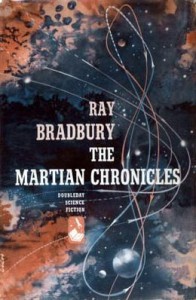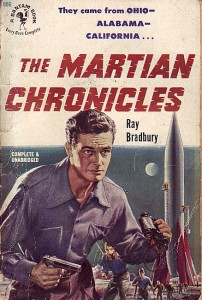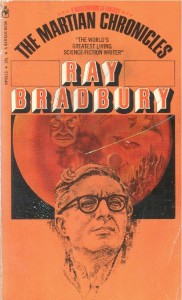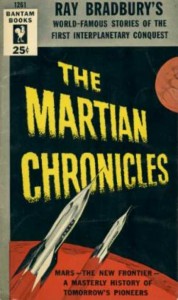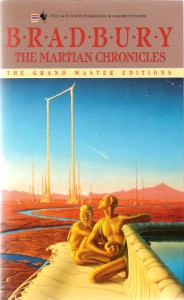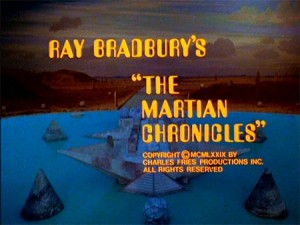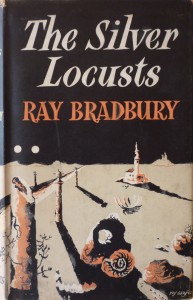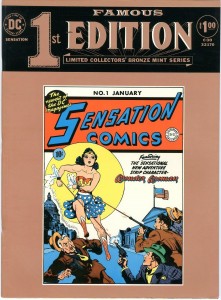I wrote this article during a delightful weekend at Mysticon 2012 in Roanoke, VA. I’d like to publicly thank the MystiCon committee and staff for allowing me to be part of a fantastic convention. I was on a handful of panels which were well-attended and generated some fascinating discussion, and I met some great people. If you have a chance to check this one out in 2013, I’d recommend you do so. Now on to the review…
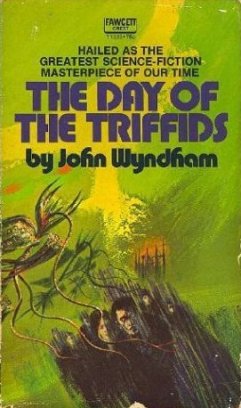
“And I really got hot when I saw Janette Scott fight a triffid that spits poison und kills…”
I forget if Janette Scott actually fought triffids, or if she just stood in the lighthouse and screamed as they encroached. I’ve tried to forget as much as I can about that movie. Sadly, it’s the movie that caused John Wyndham’s excellent book to be included in the above-quoted song, “Science Fiction Double Feature,” a paean to shlock SciFi of the Fifties and Sixties which serves as the overture to The Rocky Horror Picture Show. Double-sadly, it’s that reference which is all a lot of modern audiences know of the triffids.
“Hailed as the greatest science fiction masterpiece of our time,” says the cover of the 1969 Fawcett Crest paperback edition in my personal library. I don’t know about that, but it is a much better book than I was expecting it to be. Wyndham, also known for The Midwich Cuckoos, filmed a couple of times as The Village of the Damned, is a fairly minor deity in the science fiction pantheon. The fact that one of the largest paperback distributors of the time would make that claim, even given the hyperbolic nature of book cover copy, suggests that this book got a few people’s attention.
It would have been nice if it hadn’t gotten the producer of the 1963 film’s attention, but we can’t have everything. The film probably pulled a few more people to the book. But the film was so godawful, introducing elements which had nothing to do with the original story, giving plot details which directly contradicted the novel, all in the name of making a monster-of-the-week offering with no heart or soul, that I fear it also causes the novel to be dismissed as just a Sixties monster tale. It’s anything but. If you’re a fan of Robert Kirkman’s The Walking Dead, in either TV series or graphic novel format, you should give The Day of the Triffids a try. You’ll find a lot of the roots of the post-apocalyptic tales that currently so enthrall us in the form of Zombie stories.
It begins so blithely that it’s almost ridiculous. “When a day that you happen to know is Wednesday starts off by sounding like Sunday, there is something seriously wrong somewhere.” It such an English sentiment, and it seems to belong at the lead of a story about the daughter of a Lord who lives in a boarding school.” The tongue-in-cheek, pastoral tone doesn’t last. Like Rick in The Walking Dead and Cillian Murphy’s character in 28 Days Later, Bill Masen awakes in a hospital to find out that the world has ended, at least, he qualifies, the world as he has known it for three decades. The reason a Wednesday sounds like a Sunday is not the Bill is fanciful and silly, but because Sunday is the only day that the main road outside his hospital is usually empty of noisy traffic. This, as well as the failure of his nurse to make her morning visit to him precisely at 7:03 as is her unfailing habit, are his first clues that all is not well.
Masen learns that, while he slept Tuesday night, his eyes bandaged, the world went blind. He happened to be in the hospital because of a work-related injury: Masen is a triffid farmer, or perhaps a triffid keeper. Triffids, we quickly learn, are a new plant mutation. They are tall, ambulatory, apparently capable of communicating… and they’re carnivorous. They use a whip-like appendage to inject venom into their prey and then feast on its dead flesh. No one knows where they came from. I always assumed, because I’d seen about five minutes of the 1960s film, that they came from outer space. This idea is dismissed by Masen, who considers them a product of bioengineering, and possibly even a by-product of Soviet experiments. Whenceever they came (is “whenceever” a word? My spell check doesn’t think so, but its vocabulary is limited. I think it went to public school before No Child Left Behind came along to guarantee quality…), the triffids are ingrained into human society by the time the story begins. They are “docked” and kept as decorative plants. They are farmed like cattle on ranches, harvested for the useful oils their bodies produce.
The triffids had nothing to do with the sudden plague of blindness, as far as anyone knows. It was caused by a striking, green meteor shower of unknown origins. Its effect of leaving the majority of the population crippled by loss of sight, however, leaves no one to care for the formerly tamed, or at least confined, triffids. The docked plants, able to regrow their venomous appendages if they are not regularly pruned, together with their no-longer supervised free-range brethren, begin to literally take over the world. A scenes of Masen and his cohorts, holed up in country houses, fending off attacks by a swarm of the plants, could be neatly dropped into any zombie apocalypse story, and, indeed, probably has been. Also, like Kirkman’s Walking Dead heroes, they raid abandoned cities for supplies, dodging walking vegetables and desperate, predatory humans all the way.
If all of this sounds a bit like the worst excesses of Lost in Space (and conjures up pictures of poor Stanley Adams in a giant carrot suit), then I’m not doing it justice. The existence of walking, flesh eating plants as a threat to the protagonists does nothing to make the tone of the story ridiculous, to reduce the horror, or to mitigate Wyndham’s thought provoking depictions of human nature at its worst. He shows humanity descending almost immediately to slavery, as the blind majority kidnaps the sighted, including Masen and the woman he’s met and fallen in love with, and literally chains them to gangs of blind victims. These captives, like seeing eye dogs, are to lead their charges through the deserted streets of a fallen civilization, finding them food and shelter.
Puritanism is ridiculed, and the ephemeral nature of social mores touched upon. A sighted leader named Beadley, one of an enclave Masen and his love Joella encounter while searching London, proposes to found a colony of the seeing. He wants to be self-sustaining, and he wants the women to have as many babies as possible, to build the population. Consequently, the men will have several wives, which only makes sense if population growth is your goal and men are scarce. A man doesn’t need nine months to do his part in baby-making, after all. And Wyndham is careful to establish that there’s no belief that sightless people would have sightless babies. Only that the few sighted people there are will have an easier time building a colony, and it needs children to have a future. Of course, there’s a lot of protest against this idea.
“It will not be easy; old prejudices die hard. The simple rely on a bolstering mass of maxim and precept; so do the mentally lazy – and so do all of us, more than we imagine.”
This kind of analysis, attack, even, on traditional morality is one of the mainstays of traditional science fiction. It’s what makes a space opera, a monster story, a shoot-em-up into a thought-provoking work of fiction. It’s what makes a work that the pedestrian would label “SciFi” into real speculative fiction. Here I’m talking about written science fiction. Television has yet to really accomplish this feat. The most we’ve seen is an attempt to fool the viewer into believing that a kind of cowardly political correctness is a fierce indictment of prejudice or chauvinism. Television is always years behind print media in addressing issues. Perhaps that’s because stupid people don’t read, and the stupid are the loudest proponents of ideas and attitude which we need to shed. Still, how long after Brown v. Board of Education was it before we saw a condemnation of racial discrimination on a popular TV show? And sure, there are gay characters on TV now, but the almighty Star Trek managed to creep (zombie-like) through five iterations and never made a splash in that pond. (Or did Enterprise do so? I gave up when I realized the dog was the smartest character. I don’t hate Star Trek, BTW. I just think all those sequels failed to live up to the potential it had as a TV series in the Sixties or a movie series in the Eighties.)
I shan’t ruin your enjoyment of The Day of the Triffids by giving you a complete plot summary. Those are available out there anyway, if you want one. But I hope you’ll read or listen to this classic of the genre, and enjoy it as much as I did. I will point out that, unlike your standard monster-of-the-week story (and unlike the 1963 film) the novel does not resolve the problem of the triffids, nor of the plague of blindness, nor of the subsequent plague which begins killing the population. It leaves Masen and his comrades doing what we all do – struggling to survive in a world where non-self-aware vegetables want to consume us for sustenance, and our more predatory brethren want to press us into service to meet their needs.
Heh. You think I’m exaggerating, don’t you?

